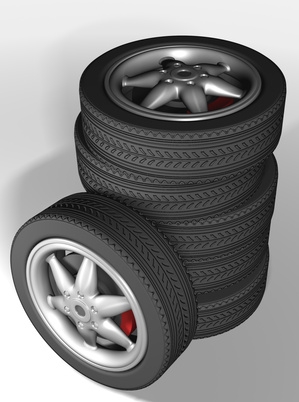
Properly maintaining your car's tires is critical to ensuring their long service life and the best fuel economy possible. Poorly maintained tires can wear prematurely and cause your car to consume larger amounts of fuel, increasing the costs of operating the vehicle. Keeping your tire pressure at the proper level is one of the simplest ways to make sure that you get the best performance from your tires and is cheap insurance against future problems.
Tire pressure should be checked once a month. A tire inflated to 35 psi can lose up to 1 psi of pressure per month. The pressure on all four tires should be checked at the same time. The pressure of the spare tire should also be checked to ensure that the spare is in good condition and ready for use if needed.
Tire pressure should be kept at the manufacturer's recommended levels. This is usually found on the door jamb, on the glove compartment door or in the owner's manual. Do not use the pressure printed on the sidewall of the tires. These numbers are the tire manufacturer's highest allowable pressure ratings for the tire, not the vehicle manufacturer's recommended operating pressure ratings.
Avoid using public gauges at gas stations or convenience stores. These gauges often are abused and give unreliable pressure readings. Purchase a quality tire pressure gauge from an auto parts store and keep it protected from dirt and damage. To use a pressure gauge, simply remove the cap from the valve stem and push the connector on the gauge onto the valve stem and observe the reading on the gauge.
Valve stems are where the air hose is connected to the tire to fill it with air and the pressure gauge is connected to check pressure. These valves are usually made of rubber and deteriorate over time. They should be replaced each time you have new tires installed on the vehicle. Valve caps help to keep dirt and contaminants out of the valve stem, and should always be screwed back onto the valve stem after checking the tire pressure.
Tire pressure should be checked when the tires are cold to get an accurate reading. Since air expands when heated, tire pressure can vary with how warm the tire is. Check the pressure before the vehicle is driven or at least three hours after it has been driven. Do not overinflate or underinflate tires. Too much or too little air pressure in the tire can cause uneven wearing of the tread, poor handling of the vehicle, increased fuel consumption, and--in severe cases--tire failure.